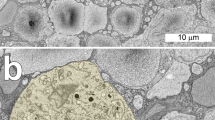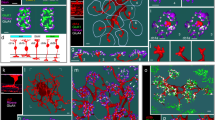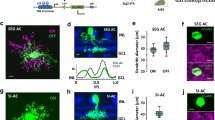Abstract
WHEN light is absorbed in the outer segment at one end of a vertebrate retinal rod or cone, sensory signals quickly reach its other end where its synapse with the visual system lies. Because rods and cones resemble short neurones in structure, it is thought that these signals travel as membrane polarization induced by light-activated current generators in the outer segments. Indeed, the membrane potentials of some rods and cones do increase in light1–3, but it is not clear whether the effect is primary and not the result of synaptic feedback from deeper retinal neurones. Attempts to show that the outer segments are sources of membrane current by analysing the a-wave and PIII components of the electroretinogram4 with intraretinal microelectrodes have not yielded consistent results, however5–8. We have therefore studied the spatial distribution of membrane current of the rods of the rat retina by an improved method using arrays of extracellular microelectrodes inserted in the receptor layer under direct vision by infrared microscopy.
This is a preview of subscription content, access via your institution
Access options
Subscribe to this journal
Receive 51 print issues and online access
$199.00 per year
only $3.90 per issue
Buy this article
- Purchase on Springer Link
- Instant access to full article PDF
Prices may be subject to local taxes which are calculated during checkout
Similar content being viewed by others
References
Tomita, T., Cold Spring Harbor Symp. Quant. Biol., 30, 559 (1965).
Kaneko, A., and Hashimoto, H., Vision Res., 7, 847 (1967).
Bortoff, A., and Norton, A., Vision Res., 7, 253 (1967); Vision Res., 5, 527 (1965). Bortoff, A., Vision Res., 4, 627 (1964).
Granit, R., Sensory Mechanisms of the Retina (Hafner, New York, 1963).
Byzov, A. L., Cold Spring Harbor Symp. Quant. Biol., 30, 547 (1965).
Tomita, T., J. Opt. Soc. Amer., 53, 49 (1963).
Brown, K. T., and Wiesel, T. N., J. Physiol., 158, 229 (1961); J. Physiol., 158, 257 (1961).
Brown, K. T., Watanabe, K., and Murakami, M., Cold Spring Harbor Symp. Quant. Biol., 30, 457 (1965).
Hagins, W. A., Zonana, H. V., and Adams, R. G., Nature, 194, 844 (1962). Hagins, W. A., Cold Spring Harbor Symp. Quant. Biol., 30, 403 (1965).
Van der Pol, B., and Bremmer, H., Operational Calculus Based on the Two Sided Laplace Integral, second ed. (Cambridge University Press, Cambridge, 1956).
Hecht, S., Shlaer, S. S., and Pirenne, M. H., J. Gen. Physiol., 25, 819 (1942).
Hagins, W. A., thesis, Cambridge Univ. (1957).
Author information
Authors and Affiliations
Rights and permissions
About this article
Cite this article
PENN, R., HAGINS, W. Signal Transmission along Retinal Rods and the Origin of the Electroretinographic a-Wave. Nature 223, 201–205 (1969). https://doi.org/10.1038/223201a0
Received:
Revised:
Issue Date:
DOI: https://doi.org/10.1038/223201a0
This article is cited by
-
Human equivalent doses of l-DOPA rescues retinal morphology and visual function in a murine model of albinism
Scientific Reports (2023)
-
Impact of keratoprosthesis implantation on retinal and visual pathway function assessed by electrophysiological testing
Graefe's Archive for Clinical and Experimental Ophthalmology (2023)
-
Electrophysiological evaluation and 18-month follow-up of two regimens with aflibercept for neovascular age-related macular degeneration
Documenta Ophthalmologica (2022)
-
Photopic negative response using a handheld mini-ganzfeld stimulator in healthy adults: normative values, intra- and inter-session variability
Documenta Ophthalmologica (2021)
-
The acute effect of atropine eye drops on the human full-field electroretinogram
Documenta Ophthalmologica (2021)
Comments
By submitting a comment you agree to abide by our Terms and Community Guidelines. If you find something abusive or that does not comply with our terms or guidelines please flag it as inappropriate.



